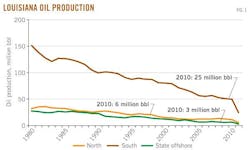How Haynesville shale will lift Louisiana's gas production profile
Mark J. Kaiser
Yunke Yu
Louisiana State University
Baton Rouge
Conventional oil and gas production in Louisiana has been in steady decline for 4 decades, but in recent years, new technology and innovation has opened up a new resource play in the Haynesville shale that is expected to play an important role in the state for many years.
In the past 5 years, shale gas has reversed Louisiana's gas production decline and promises significant growth potential in the future.
The purpose of this article is to present hydrocarbon production scenarios for Louisiana based on a transparent analytic framework and a well-defined set of assumptions. We disaggregate resource classes into three modules based on producing fields, undiscovered conventional fields, and undiscovered unconventional fields.
We employ a field-level evaluation for producing fields and categorize by primary product, resource category, geographic area, age, and production class. Undiscovered fields have not yet been discovered and are therefore conjectural. Undiscovered fields are classified according to conventional and unconventional categories and are treated using a probabilistic and scenario-based forecast to reflect the uncertainty levels in the resource categories.
In recent years the need for long-term forecasting has become more important for planning purposes and to facilitate efficient regulatory development and incentive programs as the largest oil and gas fields diminish in productivity and the promise of unconventional production is realized.
Louisiana is in the early stage of transitioning to a gas producing state, and the manner in which the Haynesville develops will play a critical role in deliverability and economic prospects in the future.
Historical production
Drilling for oil first took place in Louisiana in 1866, but it was not until the Texas success at Spindletop in 1901 that drillers returned to Louisiana and discovered oil at Jennings.1
In the 1930s and 1940s, exploration moved south into the marsh and swamplands, and in 1955, state offshore production began. In recent years, the Haynesville shale has been the target of enormous capital expenditures and has created great excitement because of the large volume of resources estimated to be economically recoverable in the region.
Oil production rose rapidly after World War II and has been in steady decline since peaking in 1970. Today, oil production is 24% of its 1965 peak in North Louisiana, 12% of its 1970 peak in South Louisiana, and 9% of its 1970 peak in state waters. Gas production has followed a broadly similar trend except its decline has been less dramatic, and over the last few years, production from the Haynesville has dramatically reversed the decline.
Most oil is produced in South Louisiana. Offshore production has never exceeded 10% of the state total and comprises the majority of production from state-owned lands (Fig. 1). In North Louisiana, gas production has doubled in the last 3 years while the South and offshore regions continue along a downward decline (Fig. 2).
Proved reserves
Oil and gas production in Louisiana plays an important role in US production and is an important source of state revenue.
In 2009, Louisiana ranked fifth in oil production and fourth in gas production in the US, and according to the Energy Information Administration, Louisiana has proved reserves of 388 million bbl of oil, 11.6 tcf of gas, and 300 million bbl of natural gas liquids—about 2% of US proved oil reserves, 5% of its proved gas reserves, and 3% of its NGL reserves.2 3
The Haynesville shale is one of several unconventional gas plays that have been discovered in the US in the past decade that promise to dramatically change the course of energy development. Technically recoverable resources in the Haynesville have been estimated at 73 to 289 tcf, making the region one of the largest shale plays in the US.
Technically recoverable resources are not proved reserves, because the capital has not been spent to prove up the resource,4 but even if the lower bound estimate was reliable this would essentially quadruple the total hydrocarbon reserves in the state.
Displaying 1/6 Page1, 2, 3, 4, 5, 6Next>
View Article as Single page


